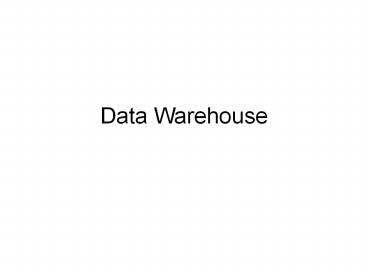Data Warehouse PowerPoint PPT Presentation
Title: Data Warehouse
1
Data Warehouse
2
Design DataWarehouse
3
Key Design Considerations
- it is important to consider the intended purpose
of the data warehouse or business intelligence
solution in order to ensure the design aligns to
business requirements.
4
Business Scenario
- An electronics manufacturer has recently acquired
a competitor to extend its existing product line.
- The acquisition has provided them with an
established customer base in a new geographic
region that was considered for development. - The manufacturer plans future acquisitions to
strengthen the current portfolio and enable
growth. - While the acquisition presents new opportunities
for expansion and growth, competition across
existing product lines and higher raw material
costs have limited their ability to expand. - In addition, the manufacturer has encountered
several internal challenges that have limited
growth.
5
The Challenges
- Latency and inaccuracies in receiving sales
information. - Inability to determine profitability by product
and product line. - Poor quality of information.
- Difficulty in forecasting sales leading to higher
inventory carrying costs. - Inaccuracies in calculating sales commissions.
- Needed information regarding sales, inventory
levels, and manufacturing commitments to raw
materials for product managers. - Use of spreadsheets in analysis of sales,
manufacturing, and finance data extracted from
ERP systems.
6
The Challenges
- Difficulty in identifying root cause of
manufacturing issues due to the inability to
access supporting detailed data. - Inability to accurately predict the most
marketable bundles of products that maximize
profits, utilize excess manufacturing capacity,
and reduce inventory levels. - Difficulty in satisfying the reporting needs of
diverse user communities due to multiple tools,
inconsistent definitions, and complexities
encountered in finding and understanding data.
7
The Proposed Solution
- The proposed solution will be used by sales,
finance, and manufacturing to answer the most
significant queries - Sales analysis
- What are the sales by quarter, sales
representative, and geography? - How are sales trending to industry forecasts?
- How do sales compare in the Northeast to
Southwest?
8
The Proposed Solution
- Product profitability
- Which product lines are the highest revenue
producers this year? - Which products and product lines are the most
profitable this quarter? - Which product lines are above seasonal forecasts?
- Sales representative analysis
- Who are the top five sales representatives by
sales volume? - Who are the most productive sales representatives
in divisions, regions, and territories? - Which sales divisions, regions, and territories
generate the highest revenues and margins?
9
The Proposed Solution
- Customer analysis
- Who are the best customers?
- Who are the most profitable customers?
- What percentage of sales is generated from the
top five customers? - Which customers purchase the most products by
product line? - Which industry has experienced the fastest growth
over last year?
10
Normalized Design
11
Dimensional Design
- Dimensional design is a denormalization technique
used in providing an intuitive view of
historically correct information that corresponds
to the needs of users. - Commonly referred to as star schema design,
dimensional designs are subject-oriented
structures comprised of fact tables and dimension
tables.
12
Dimensional Design
- Fact tables represent processes, events, or
activities that are used in measuring a business.
- A fact table is comprised of two types of
columns foreign key references to dimension
tables and to measures. - Foreign key columns are provided to join the fact
table to dimension tables that enable the
filtering and constraining of data.
13
Dimensional Design
- Dimension tables contain attributes and
hierarchies that enable a logical grouping and
constraining of data. - Dimension attributes are normally descriptive and
represent details about the dimension. - Hierarchies within a dimension provide a natural
summarization of information ranging from the
lowest level of detail to the highest summary
level. - The most common hierarchy in dimensional designs
is the time hierarchy that provides multiple
levels that typically range from day, week, and
month to year.
14
Dimensional Design
- Measures or metrics represent the information
that is to be measured about a business process
or event. - Measures represent information that is specific
about one or more dimensional values. - In this example, the measures captured are
quantity, sales, profit, and commission.
15
Dimensional Design
16
Dimensional Design
17
Dimensional Design
18
Benefit from a Hybrid Design
- Flexibility to extend
- Ease of use
- Subject-area centric
- Quality initiatives
19
Online Analytical Processing Design
- The Oracle OLAP engine uses what is called an
analytic workspace as a multidimensional data
structure to support analytic processing. - When constructing our OLAP design, the analytic
workspace is built by logically defining
dimensions, levels, hierarchies, attributes,
cubes, measures, and mappings prior to physically
loading data from a relational source.
20
Online Analytical Processing Design
- The OLAP cube provides a logical multidimensional
representation used to organize metrics that
share the same relationships for analysis. - The edges of a cube represent the dimensions used
for filtering and constraining while the body of
the cube contains one or more metrics or measures
used in measuring a business process or event. - In our example, we created a sales cube that is
dimensioned by time, customer, product, and sales
rep in a manner similar to the dimensional model.

